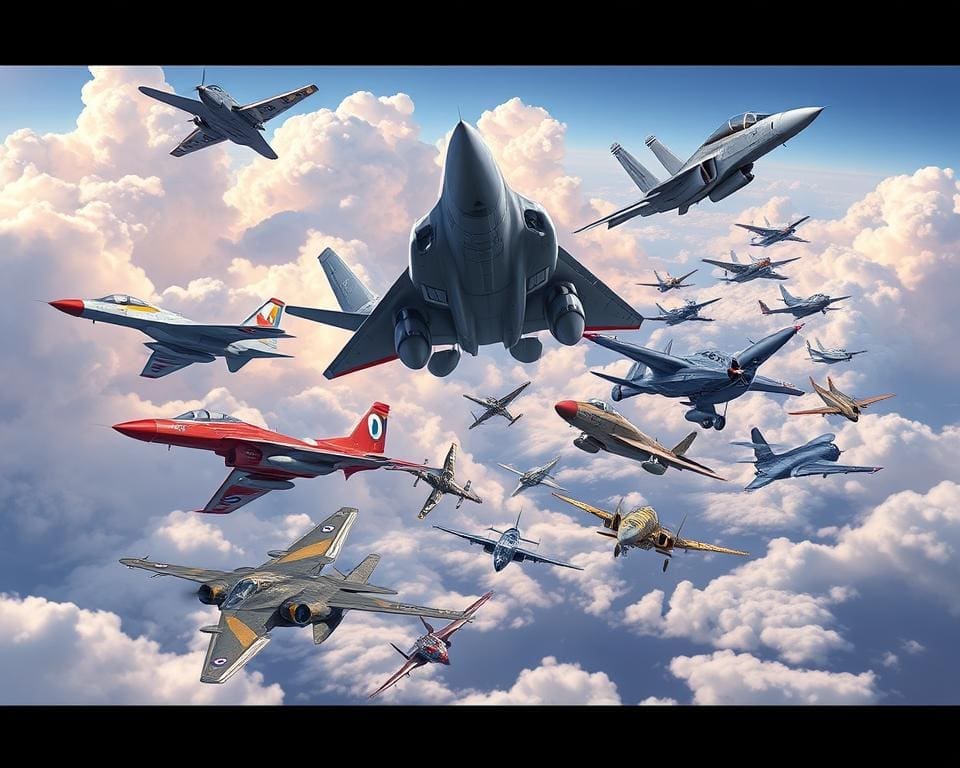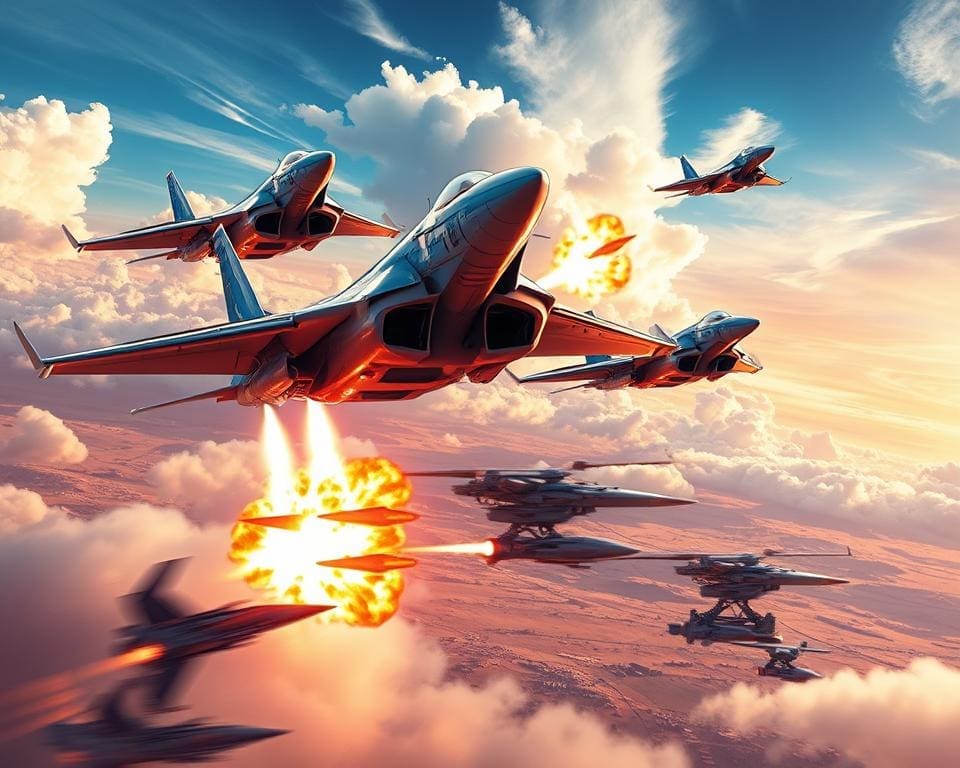The dynamic realm of aerial warfare has evolved significantly, with fighter jets becoming the vanguard of military aviation technology. As nations strive for air superiority, the interaction between these agile aircraft and modern air defences reveals a complex battlefield landscape. The effectiveness of platforms like the F-35 Lightning II against advanced missile defence systems exemplifies how innovation reshapes tactical strategies. This article explores the intricate dance of technology and warfare, emphasising the critical importance of securing air dominance in today’s conflicts.
The Evolution of Fighter Jets
The journey of fighter aircraft has been nothing short of remarkable, showcasing a transformation influenced by conflict, innovation, and the relentless pursuit of aerial supremacy. From the early days of biplanes to the sophisticated multirole fighters of today, the history of fighter jets reflects a profound evolution shaped by the necessities of modern warfare and notable technological advancements.
Historical Development of Fighter Aircraft
The historical development of fighter aircraft began during World War I, where rudimentary machines like the Sopwith Camel and Fokker Dr.I played pivotal roles in air combat. As the years progressed through World War II and into the Cold War, fighter jets underwent significant upgrades. Iconic models such as the Supermarine Spitfire and North American P-51 Mustang introduced speed and agility, transforming aerial engagements. The arms race of the Cold War saw the advent of jet propulsion, enabling aircraft to reach supersonic speeds, laying the groundwork for future designs.
Key Technological Advancements
A multitude of technological advancements has redefined the capabilities of fighter aircraft. Innovations in avionics revolutionised navigation and targeting systems, while the introduction of stealth technologies minimised visibility to enemy radar. Modern fighter jets, including the Eurofighter Typhoon and Lockheed Martin F-22 Raptor, exemplify these advancements with their integrated systems that enhance combat effectiveness. These technologies allow for superior situational awareness, improved manoeuvrability, and increased survivability in diverse combat scenarios.

Fighter Jets vs. Modern Air Defenses
The landscape of aerial warfare has transformed dramatically, presenting fighter jets with significant tactical hurdles against modern air defences. Understanding these challenges and the countermeasures available is vital for air forces around the globe.
Strategies for Engaging Air Defence Systems
To effectively engage sophisticated air defence systems, air forces implement a variety of strategies for engaging, highlighting the crucial need for adaptability. These tactics include:
- Electronic warfare techniques to disrupt enemy radar and communications.
- Utilisation of decoys to confuse missile guidance systems.
- Coordinated attacks to overwhelm defence systems with multiple targets.
- Stealth technology to minimise detection by advanced tracking systems.
Each strategy aims to enhance the survivability of fighter jets while successfully penetrating robust air defences.
Understanding Advanced Missile Defence Systems
Advanced missile defence systems pose a formidable challenge in the ongoing conflict of fighter jets vs. modern air defences. Systems like the Aegis and S-400 exemplify the level of sophistication present in today’s military arsenals. These systems are designed to:
- Track and engage multiple aerial threats simultaneously.
- Utilise advanced algorithms for accurate targeting.
- Integrate various sensors, enhancing overall situational awareness.
In recognising the capabilities of these platforms, air forces can better prepare for engagements, developing tactics that synergise offensive capabilities with effective countermeasures.
Air Superiority: The Battlefield of the Skies
In the realm of modern warfare, the quest for air superiority serves as a pivotal objective for military forces. The role of fighter jets in achieving this supremacy cannot be overstated. From their interception capabilities to ground support functions, these aircraft are crucial for securing control of the skies and dictating the tempo of conflict.
Role of Fighter Jets in Achieving Air Supremacy
Fighter jets act as the vanguard of air operations. Their multifaceted roles encompass:
- Interception: Engaging incoming threats before they can impact ground forces.
- Ground Support: Providing close air support, enhancing the effectiveness of ground troops.
- Surveillance: Offering real-time intelligence to commanders, thereby aiding in strategic decision-making.
- Electronic Warfare: Disrupting enemy communications and radar systems, thereby enhancing operational effectiveness.
The effectiveness of these roles ultimately contributes to the broader aim of achieving air superiority, allowing nations to control and dominate aerial engagements.
Impact of Air Defence Systems on Military Strategy
The evolution of air defence systems has transformed military strategies across the globe. These advanced systems challenge the aforementioned roles of fighter jets by introducing formidable obstacles such as:
- Advanced Missiles: Capable of targeting aircraft at various altitudes, altering engagement tactics.
- Integrated Defence Networks: Enhancing situational awareness and allowing for coordinated responses.
- Stealth Technologies: Influencing how fighter jets are designed and deployed in combat scenarios.
Operations in various conflict zones, such as Syria and Libya, demonstrate the intricate balance between offensive capabilities and the defensive measures required to ensure air superiority. A sustained investment in both offensive and defensive technologies is essential for maintaining an advantage in this ever-evolving battlefield.
The Rise of Advanced Military Aviation Technology
The landscape of military aviation technology is advancing at an unparalleled rate. Innovations in stealth capabilities and speeds have transformed the design and functionality of modern fighter jets. These advancements not only enhance combat effectiveness but also redefine strategic approaches in aerial warfare.
Innovations in Stealth and Speed
Modern fighter jets are equipped with cutting-edge technologies that significantly reduce their radar cross-sections. Features such as angled surfaces, advanced materials, and internal weapons bays contribute to superior stealth characteristics. Aircraft like the Northrop Grumman B-21 Raider epitomise these advancements, showcasing a design aimed at achieving maximum invisibility while maintaining high-speed performance. This combination enables pilots to penetrate enemy airspace with less risk, altering the dynamics of military engagements.
Integration of Artificial Intelligence in Combat
The role of artificial intelligence in military aviation cannot be overstated. AI systems facilitate essential decision-making support, enabling rapid analysis of complex combat scenarios. Jet fighters equipped with AI can autonomously execute specific tasks, allowing human pilots to focus on overarching strategic objectives. This integration promises a future where data-driven tactics enhance operational effectiveness, making aerial confrontations more strategic than ever before.
Air-to-Air Combat Tactics
In an era defined by rapid technological advancements, air-to-air combat has transformed significantly. As the landscape of warfare evolves, so too do the tactics employed by pilots in the heat of battle. A comparison of traditional dogfighting techniques with contemporary methods reveals a shift in thinking and strategy, essential for survival and dominance in the skies.
Dogfighting Techniques vs. Modern Weaponry
Historically, dogfighting techniques relied on close-range manoeuvrability and pilot skill, where aircraft engaged one another in intense aerial duels. The adrenaline-fuelled engagements showcased the agility of jets, but the rise of advanced missile technologies, like the AIM-120 AMRAAM, has changed the dynamics. Modern air-to-air combat increasingly favours beyond-visual-range (BVR) engagements, emphasising the importance of situational awareness and technology over raw piloting ability.
Evolving Air-to-Air Combat Scenarios
The complexities of current missions have prompted the need for innovative strategies in evolving scenarios. Modern aerial battlegrounds encompass multi-domain operations, where fighter jets navigate environments teeming with drones and sophisticated radar systems. This complexity demands flexibility and adaptability, as pilots engage not just with enemy aircraft but within a web of challenges that could originate from numerous sources.
Future Trends in Air Defence Strategy
The landscape of military aviation is continuously evolving, influenced by emerging technologies and the changing nature of threats. The future trends in air defence strategy signal a significant shift towards integrated systems that merge air and missile defence mechanisms. This approach enables forces to respond more effectively to diverse threats, ensuring greater protection for both ground assets and airspace.
Another pivotal development includes the incorporation of artificial intelligence in threat detection and response systems. AI can enhance situational awareness, allowing for quicker decision-making in combat scenarios. As military forces harness these advanced technologies, the level of automation within air defence systems is expected to increase dramatically, leading to more efficient responses to potential threats.
Moreover, the ongoing evolution of countermeasures highlights how nations are adapting their air defence strategy to combat new challenges. Counter-hypersonic technologies, for example, are gaining prominence as defence agencies prepare for the potential impact of hypersonic weapons on air defence capabilities. The challenge presented by these fast-moving threats compels military aviation strategists to innovate constantly.
Understanding these future trends not only informs national security policies but also allows for a proactive approach to technological integration and battlefield preparedness. The interplay of these factors ensures that air defence remains a cornerstone of modern military strategy, ready to adapt to whatever challenges lie ahead.
Conclusion: The Ongoing Battle for Air Dominance
The realm of aerial warfare has transformed dramatically, with the intricate interplay between fighter jets and air defence systems shaping the future of military engagements. As nations advance their capabilities, air dominance emerges as a pivotal objective, commanding the necessary investment in both advanced fighter aircraft technology and robust air defence systems. This relentless arms race underscores the ever-present need for operational superiority, ensuring that armed forces remain one step ahead in potential conflicts.
Fighter jets, epitomising agility and speed, serve as crucial assets in achieving air supremacy. However, the evolution of air defence systems necessitates that military strategists continually adapt their tactics. Understanding the complexities of engagement strategies is vital, as the consequences of air superiority extend beyond mere combat; they influence the broader landscape of global security and military preparedness. It is clear that the future of aerial warfare will hinge on this delicate balance.
Ultimately, the ongoing battle for air dominance calls for a forward-thinking approach, encouraging collaboration and innovation within defence sectors. As technologies evolve, the way we perceive and achieve air dominance will undoubtedly transform, leaving a profound impact on how nations perceive threats, safeguard their interests, and prepare for the conflicts of tomorrow.









